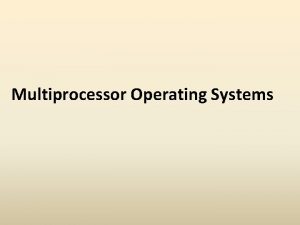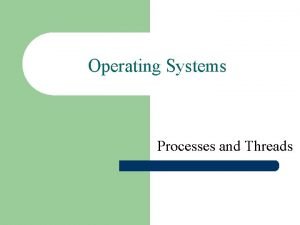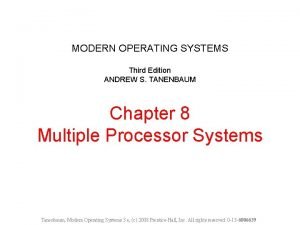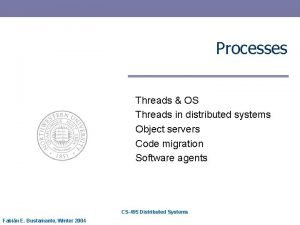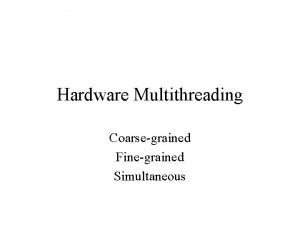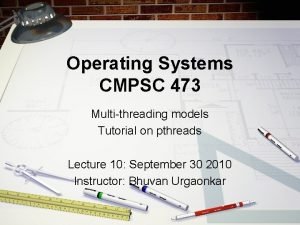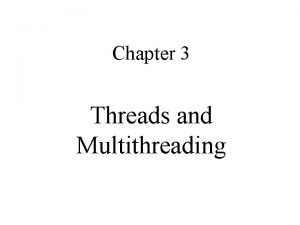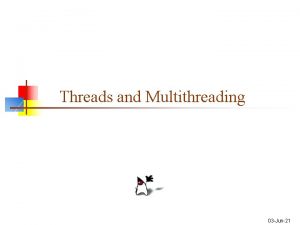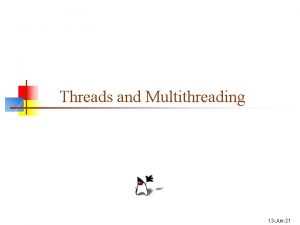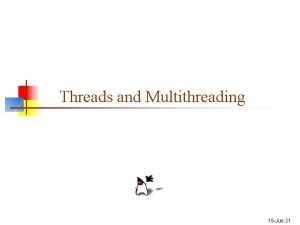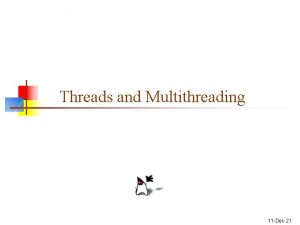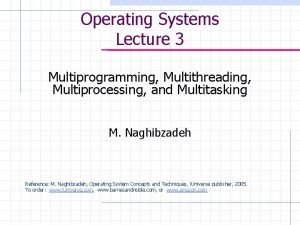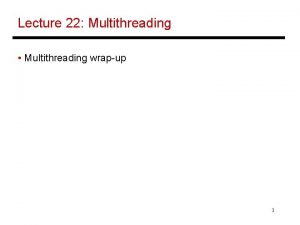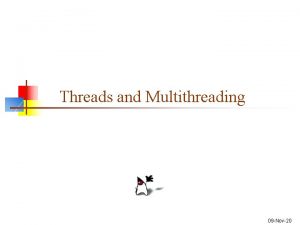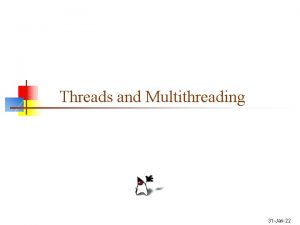Threads and Multithreading Multiprocessing Modern operating systems are






















- Slides: 22

Threads and Multithreading

Multiprocessing • Modern operating systems are multiprocessing • Appear to do more than one thing at a time • Three general approaches: – Cooperative multiprocessing – Preemptive multiprocessing – Really having multiple processors

Multithreading • Multithreading programs appear to do more than one thing at a time • Same ideas as multiprocessing, but within a single program • More efficient than multiprocessing • Java tries to hide the underlying multiprocessing implementation

Why multithreading? • Allows you to do more than one thing at once – Play music on your computer’s CD player, – Download several files in the background, – while you are writing a letter • Multithreading is essential for animation – One thread does the animation – Another thread responds to user inputs

Threads • A Thread is a single flow of control – When you step through a program, you are following a Thread • Your previous programs all had one Thread • A Thread is an Object you can create and control

Sleeping • Every program uses at least one Thread • Thread. sleep(int milliseconds); • try { Thread. sleep(1000); } catch (Interrupted. Exception e) { } • sleep only works for the current Thread

States of a Thread • A Thread can be in one of four states: – – Ready: all set to run Running: actually doing something Waiting, or blocked: needs something Dead: will never do anything again • State names vary across textbooks • You have some control, but the Java scheduler has more

State transitions waiting start ready running dead

Two ways of creating Threads • You can extend the Thread class: – class Animation extends Thread {…} – Limiting, since you can only extend one class • Or you can implement the Runnable interface: – class Animation implements Runnable {…} – requires public void run( ) • I recommend the second for most programs

Extending Thread • class Animation extends Thread { public void run( ) { code for this thread } Anything else you want in this class } • Animation anim = new Animation( ); – A newly created Thread is in the Ready state • To start the anim Thread running, call anim. start( ); • start( ) is a request to the scheduler to run the Thread --it may not happen right away • The Thread should eventually enter the Running state

Implementing Runnable • class Animation implements Runnable {…} • The Runnable interface requires run( ) – This is the “main” method of your new Thread • Animation anim = new Animation( ); • Thread my. Thread = new Thread(anim); • To start the Thread running, call my. Thread. start( ); – You do not write the start() method—it’s provided by Java • As always, start( ) is a request to the scheduler to run the Thread--it may not happen right away

Starting a Thread • • • Every Thread has a start( ) method Do not write or override start( ) You call start( ) to request a Thread to run The scheduler then (eventually) calls run( ) You must supply public void run( ) – This is where you put the code that the Thread is going to run

Extending Thread: summary class Animation extends Thread { public void run( ) { while (ok. To. Run) {. . . } } } Animation anim = new Animation( ); anim. start( );

Implementing Runnable: summary class Animation extends Applet implements Runnable { public void run( ) { while (ok. To. Run) {. . . } } } Animation anim = new Animation( ); Thread my. Thread = new Thread(anim); my. Thread. start( );

Things a Thread can do • • Thread. sleep(milliseconds) yield( ) Thread me = current. Thread( ); int my. Priority = me. get. Priority( ); me. set. Priority(NORM_PRIORITY); if (other. Thread. is. Alive( )) { … } join(other. Thread);

Animation requires two Threads • Suppose you set up Buttons and attach Listeners to those buttons. . . • …then your code goes into a loop doing the animation… • …who’s listening? – Not this code; it’s busy doing the animation • sleep(ms) doesn’t help!

How to animate • Create your buttons and attach listeners in your first (original) Thread • Create a second Thread to run the animation • Start the animation • The original Thread is free to listen to the buttons • However, – Whenever you have a GUI, Java automatically creates a second Thread for you – You only have to do this yourself for more complex programs

Things a Thread should NOT do • The Thread controls its own destiny • Deprecated methods: – my. Thread. stop( ) – my. Thread. suspend( ) – my. Thread. resume( ) • Outside control turned out to be a Bad Idea • Don’t do this!

How to control another Thread • Don’t use the deprecated methods! • Instead, put a request where the other Thread can find it • boolean ok. To. Run = true; animation. start( ); • public void run( ) { while (controller. ok. To. Run) {…}

A problem int k = 0; Thread #1: k = k + 1; Thread #2: System. out. print(k); • What gets printed as the value of k? • This is a trivial example of what is, in general, a very difficult problem

Tools for a solution • You can synchronize an object: – synchronized (obj) { code that uses/modifies obj } – No other code can use or modify this object at the same time • You can synchronize a method: – synchronized void add. One(arg 1, arg 2, . . . ) { code } – Only one synchronized method in a class can be used at a time (other methods can be used simultaneously) • Synchronization is a tool, not a solution— multithreading is in general a very hard problem

The End
 Insidan region jh
Insidan region jh Multiprocessing operating system
Multiprocessing operating system Slidetodoc.com
Slidetodoc.com Modern operating systems tanenbaum
Modern operating systems tanenbaum Rootkit
Rootkit Modern operating systems 3rd edition
Modern operating systems 3rd edition Tanenbaum structured computer organization
Tanenbaum structured computer organization Modern operating systems tanenbaum
Modern operating systems tanenbaum Threads in distributed systems
Threads in distributed systems Symmetric multiprocessing adalah
Symmetric multiprocessing adalah Multiprocessing adalah
Multiprocessing adalah Multiprocessing adalah
Multiprocessing adalah Interconnection structure of multiprocessor
Interconnection structure of multiprocessor What is simultaneous multithreading
What is simultaneous multithreading Multithreaded programming languages
Multithreaded programming languages Multitasking vs multithreading
Multitasking vs multithreading Multithreading models
Multithreading models Fine grained multithreading
Fine grained multithreading Fine grained multithreading
Fine grained multithreading Fine grained multithreading
Fine grained multithreading Fine grained multithreading
Fine grained multithreading Fine grained multithreading
Fine grained multithreading Cmpsc 473
Cmpsc 473

